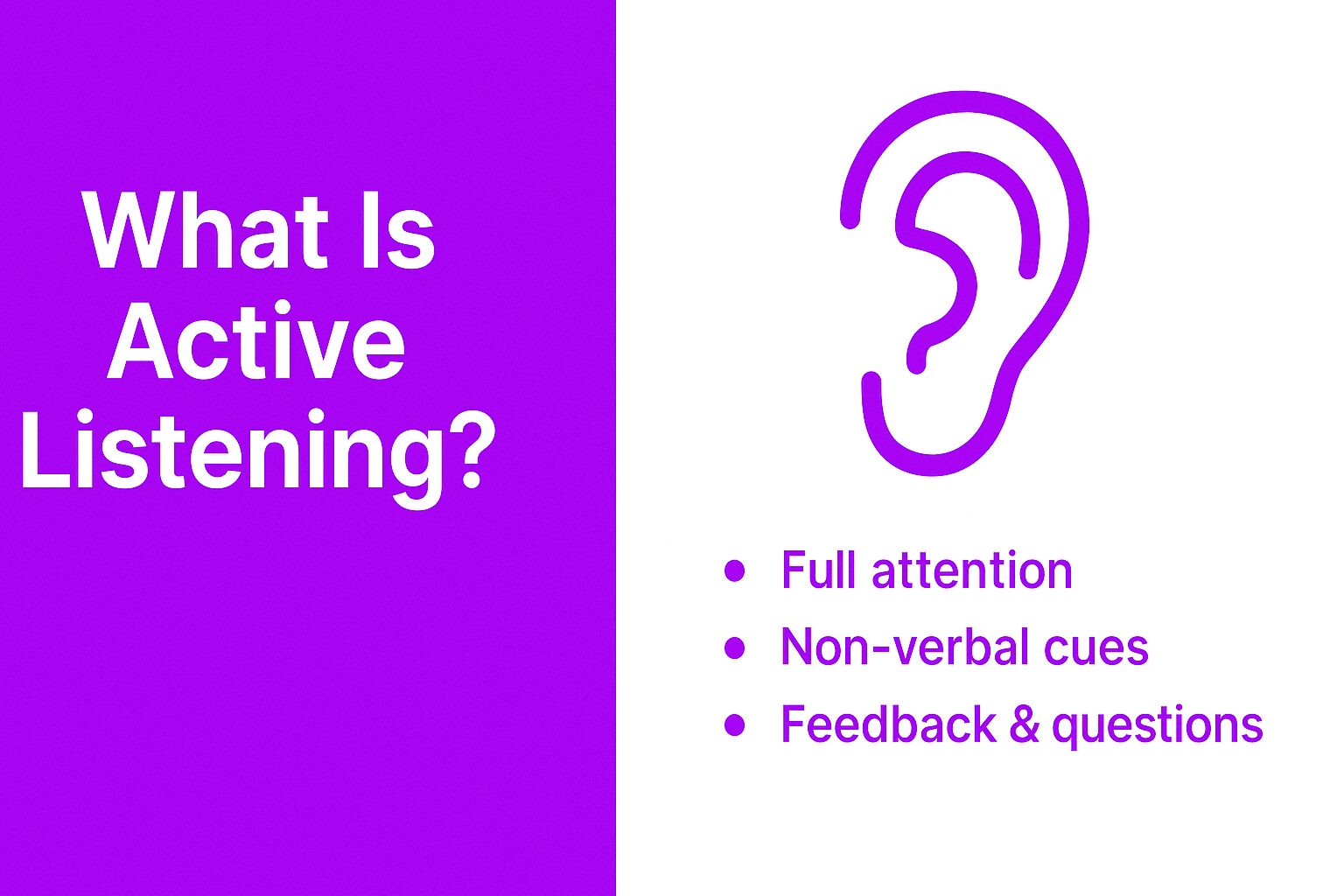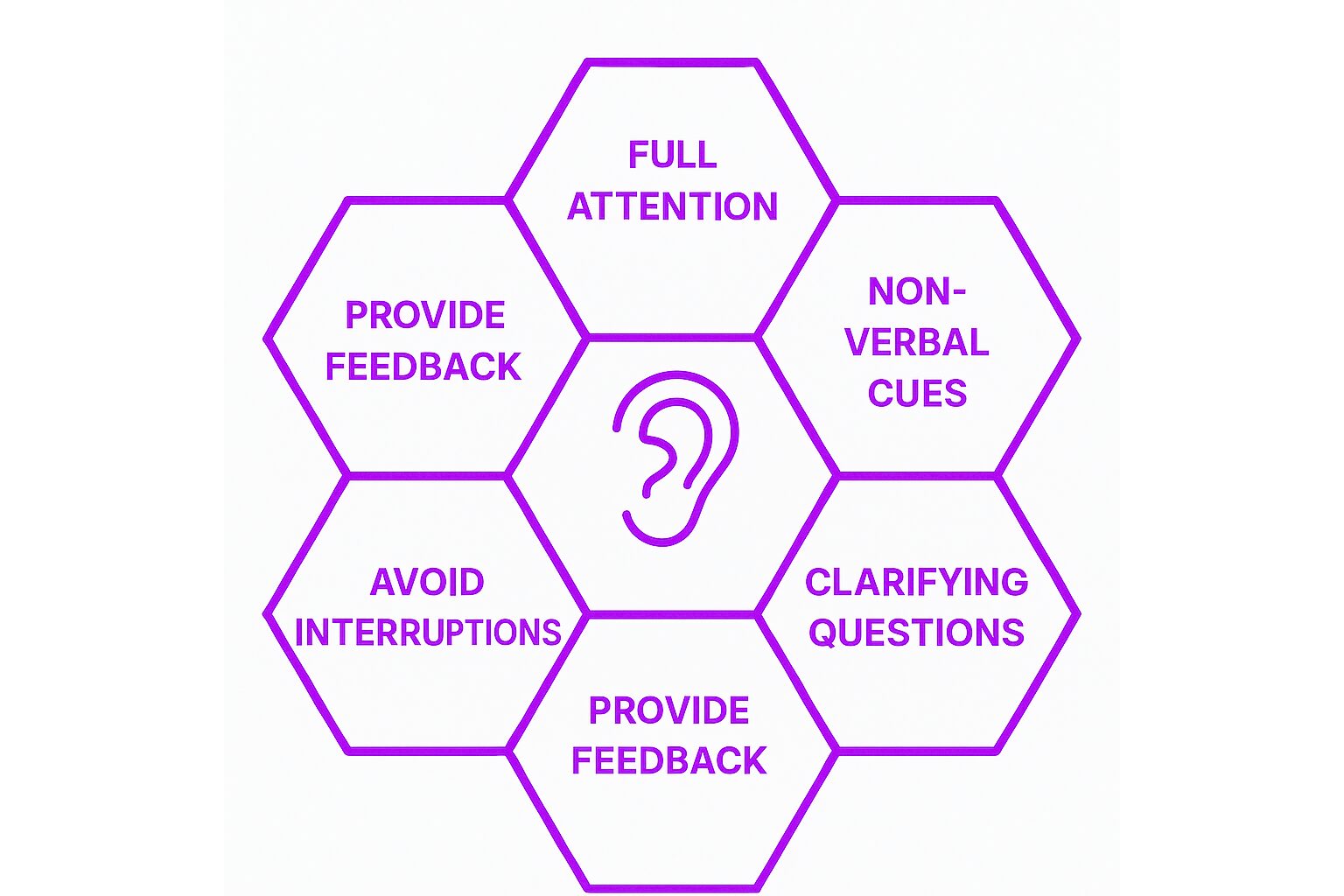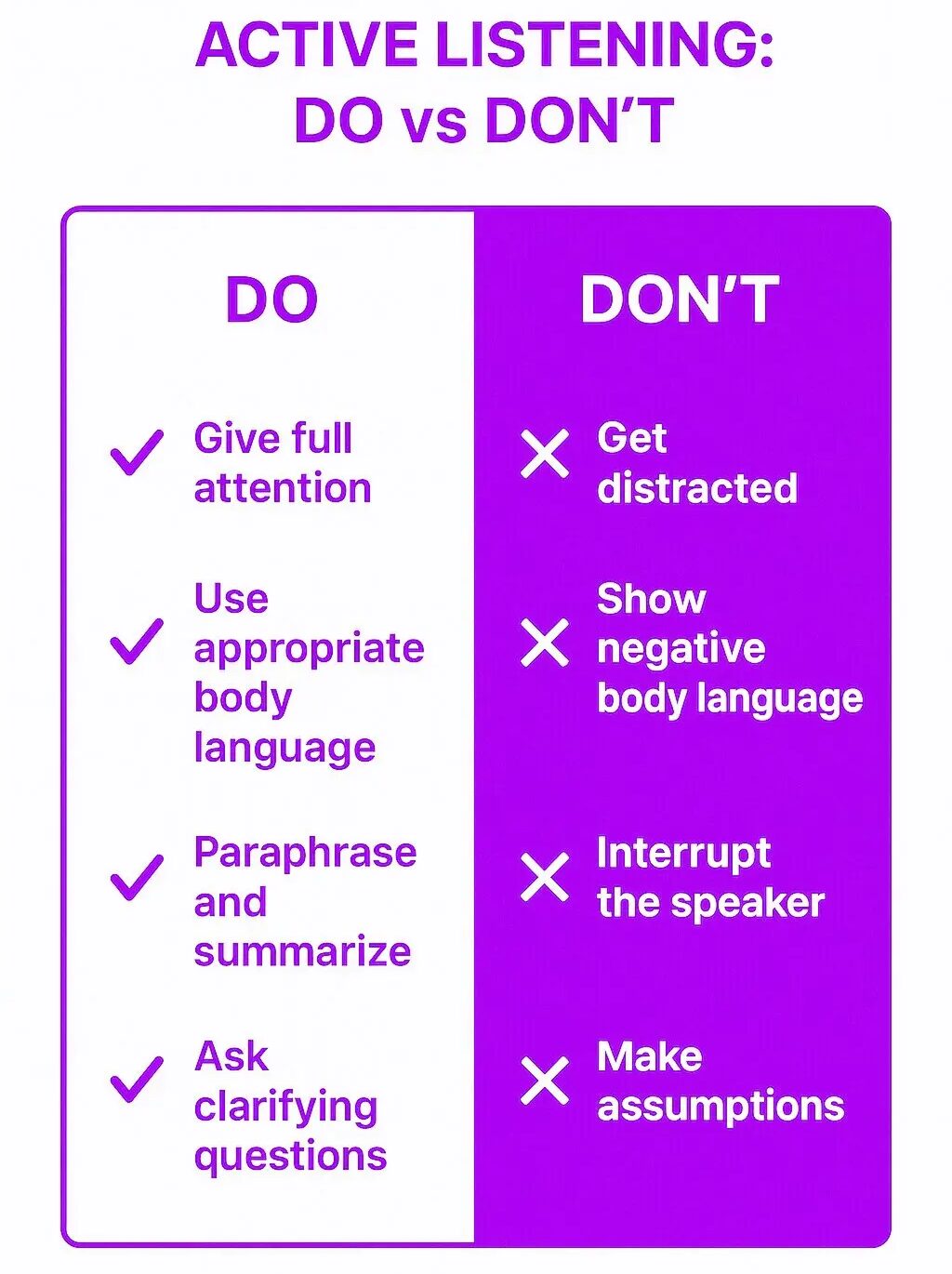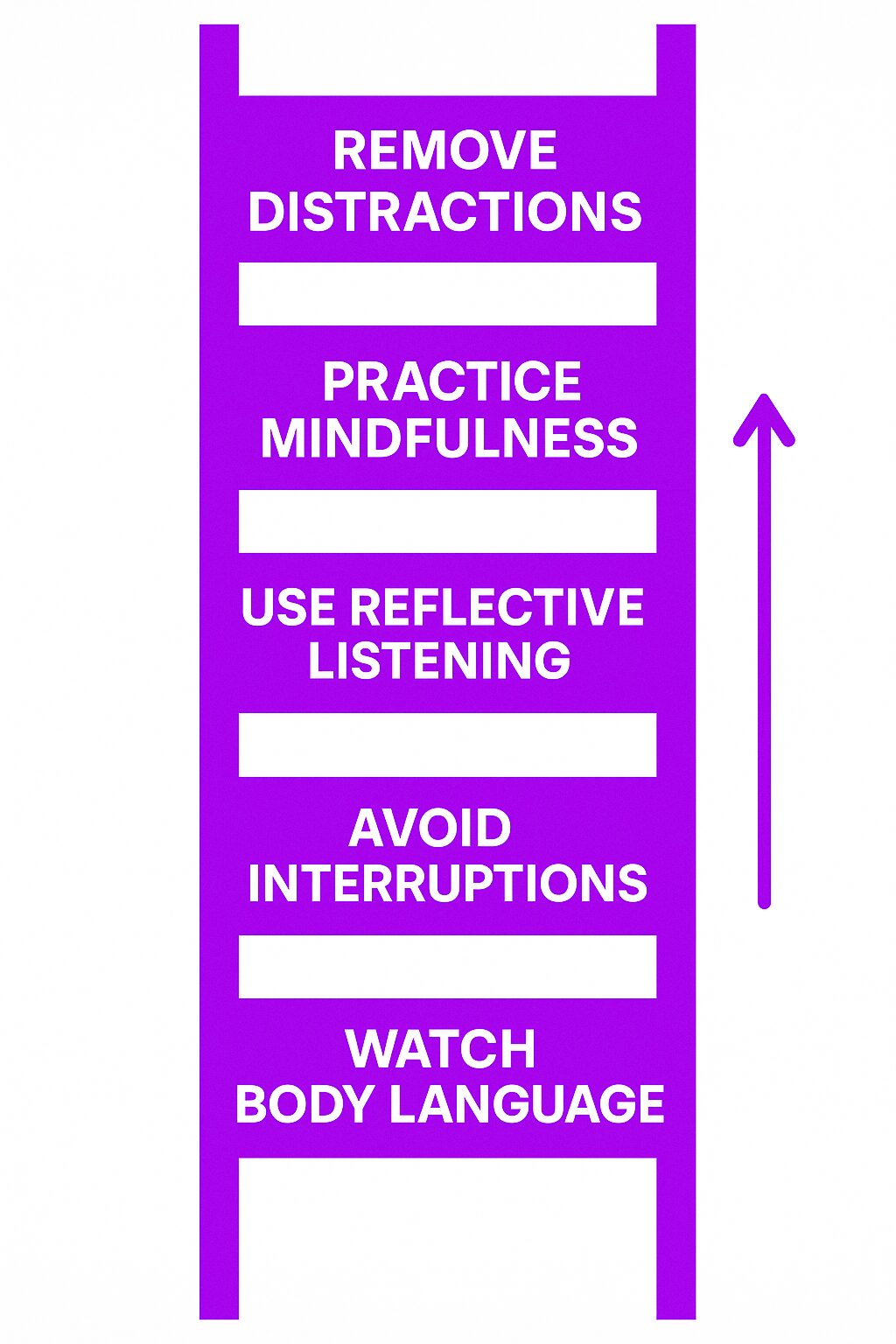What is Active Listening?

Active listening means fully focusing on a speaker, understanding their message, responding thoughtfully, and remembering what was said. The active listening technique involves summarizing key points to ensure understanding, practicing patience to allow uninterrupted speech, and reflecting or validating what is heard to confirm comprehension. It goes beyond hearing words; it involves being mentally present, acknowledging emotions, and fostering meaningful communication. This practice helps in personal and professional settings, improving relationships, teamwork, and decision-making.
How Active Listening Works
Actively listening requires intent and effort. Instead of passively absorbing information, you engage with the speaker by paying attention to verbal and non-verbal cues, asking relevant questions, and offering responses that show comprehension. This deliberate process fosters mutual understanding between speaker and listener, building trust and ensuring that conversations are productive.
Key Components of Active Listening
Active listening techniques are essential tools for enhancing effective communication across various contexts.
-
Full Attention – Stay present, maintain eye contact, and eliminate distractions.
-
Non-Verbal Cues – Use nods, facial expressions, and body language to show engagement.
-
Paraphrasing – Repeat or reword what was said to confirm understanding.
-
Clarifying Questions – Ask open-ended questions to deepen comprehension.
-
Avoiding Interruptions – Let the speaker finish before responding.
-
Providing Feedback – Offer thoughtful responses that reflect on the conversation.
Why Active Listening Matters
Strong communication is essential for personal relationships, workplace collaboration, and leadership. The active listening technique ensures clarity and mutual understanding by summarizing key points and reflecting what has been heard. Active listening helps resolve conflicts, improve productivity, and foster an inclusive environment where people feel heard and valued. It enables better decision-making and strengthens trust in teams.
Workplace Benefits
-
Better Employee Engagement – Leaders who listen actively encourage open dialogue and improve morale. Adopting active listening techniques today is crucial to enhance communication and productivity in the workplace.
-
Stronger Team Collaboration – Effective listening ensures ideas are fully understood and implemented.
-
Fewer Misunderstandings – Reduces errors and improves clarity in instructions and feedback.
-
Enhanced Problem-Solving – Encourages diverse perspectives and innovative solutions.
Barriers to Active Listening
Active listening is a skill that requires attention, focus, and empathy. However, several barriers can hinder effective active listening, making it challenging to fully engage with the speaker. These barriers can be internal, external, or a combination of both.
Challenges of Active Listening
Active listening requires focus and patience, which can be difficult in fast-paced environments. Common challenges include:
-
Distractions – External noise, digital interruptions, or personal stress can break focus.
-
Preconceived Notions – Personal biases or assumptions may impact objectivity.
-
Time Constraints – Rushing through conversations without giving full attention leads to miscommunication.
-
Emotional Barriers – Stress, anxiety, or personal conflicts can hinder the ability to listen effectively.
In contrast, critical listening is a distinct type of listening where the listener forms an opinion about what is being said, often used in debates or when engaging with a salesperson.
The Role of an Active Listener
An active listener plays a crucial role in effective communication. The responsibilities of an active listener go beyond merely hearing the speaker’s words; they involve engaging with the speaker and ensuring that the communication is clear and meaningful.
How to Improve Active Listening Skills
Remove Distractions
Silence notifications, close unnecessary tabs, and create an environment where you can focus entirely on the speaker.
Practice Mindfulness
Stay present in the conversation rather than thinking about what to say next. Be patient and let the speaker finish their thoughts.
Use Reflective Listening
Repeat key points to confirm understanding by focusing on the speaker’s words. Phrases like, “So what you’re saying is…” or “It sounds like you mean…” show that you are actively processing the message.
Ask Better Questions
Instead of yes-or-no questions, use open-ended ones like “Can you tell me more about that?” or “How did that make you feel?” This encourages deeper discussion and better understanding.
Pay Attention to Body Language
Maintain eye contact, use facial expressions that match the conversation, and avoid crossing your arms or looking away.
Active Listening Exercises
Practicing active listening exercises can help improve your listening skills and make you a better listener. Here are some exercises you can try to enhance your ability to actively listen:
Assessing Your Active Listening Skills
Assessing your active listening skills can help you identify areas for improvement and develop strategies to become a better listener. Here are some questions to ask yourself to evaluate your current listening abilities:
Active Listening in Action
Leadership and Management
A manager who listens attentively to employee concerns fosters trust and increases engagement. For example, when employees express dissatisfaction with their workload, an active listener acknowledges their concerns and works toward a reasonable solution.
Customer Service
A customer service representative practicing active listening ensures they fully understand a complaint before responding. This leads to faster resolutions and improved customer satisfaction.
Personal Relationships and Empathic Listening
In conversations with friends and family, active listening strengthens emotional connections. When someone shares a difficult experience, listening without judgment and offering supportive responses makes them feel valued and heard. Empathic listening, a type of active listening focused on truly understanding the other person, particularly when they share personal stories, plays a crucial role in building strong relationships and deepening empathy.
Common Myths About Active Listening
“Listening is Passive”
Many assume listening just means waiting for their turn to speak. True active listening is an active process that involves engagement, observation, and interpretation. A good listener practices attentive listening and engages in techniques such as reflecting and summarizing.
“Nodding Means You Understand”
While nodding can indicate attentiveness, it does not necessarily mean full comprehension. Clarification and feedback are crucial to ensuring proper understanding. Good listeners ask open-ended questions and practice attentive listening to foster better understanding.
“You Have to Agree”
Active listening does not mean agreeing with everything the speaker says. It means respecting their perspective and responding thoughtfully, even if you have a different opinion.
Conclusion
Active listening is a crucial skill in both personal and professional contexts. It fosters better relationships, improves communication, and enhances problem-solving abilities. By practicing mindful listening, asking the right questions, and providing meaningful responses, you create an environment where effective dialogue thrives. Whether in leadership, teamwork, or daily interactions, mastering active listening can significantly impact the quality of conversations and the strength of relationships.







